Mexico Series: Part 4![]()
previous article | next article
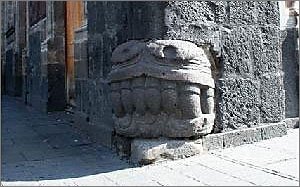 Last week right after I got back from Mendocino, I read this in The Washington Post:
Last week right after I got back from Mendocino, I read this in The Washington Post:
MEXICO CITY (AP) — Archaeologists in Mexico City have unearthed the skulls and other bones of 15 people, most of them the children of traveling merchants during Aztec times.
Researcher Alejandra Jasso Pena says they also found ceramic flutes, bowls, incense burners, the remains of a dog that was sacrificed to accompany a child in the afterlife and other artifacts of a pre-Columbian civilization.
Jasso Pena said Friday that construction was about to start on five buildings in a Mexico City neighborhood when the National Institute of Anthropology and History asked to carry out an excavation of the site first.
Experts suspected the site was an important ceremonial center for the Tepanec tribe between 1200 and 1300. The influential traders living there were called Pochtecas.
Archaeologists say excavation is continuing at the site.
It’s this kind of thing, which happens all the time in Mexico, that makes you want to understand who the Aztecs were, how they created this empire, built amazing pyramids, the remnants of which are found today in the cornerstones of museums, between rail lines at metro stops and most importantly under the concrete sidewalk next to the Metropolitan Cathedral.
For it was there in 1978 that two city electrical workers jackhammering for the metro made one of archeology’s most significant finds: the ceremonial stone depicting the Aztec moon goddess, Coyolxauhqui, which led to the excavation of the Temple Mayor, the Aztec pyramid Cortez thought he’d buried forever.
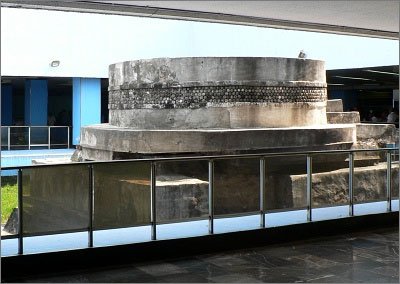 Tenochitlan, now present day Mexico City, grew up in the areas around lake Texcoco around 1300. By the time Cortez landed in Veracruz in 1519, it was one of the most intellectually, artistically developed and wealthiest empires ever to have existed in Mesoamerica.
Tenochitlan, now present day Mexico City, grew up in the areas around lake Texcoco around 1300. By the time Cortez landed in Veracruz in 1519, it was one of the most intellectually, artistically developed and wealthiest empires ever to have existed in Mesoamerica.
When the conquistadores stood on the causeway at what is now the barrio of Tepito and gazed at the Aztec City, Bernal Castillo de Diaz, one of Coretz’s soldiers wrote:
And when we saw all those cities and villages built in the water, and other great towns on dry land, and that straight and level causeway leading to Mexico [i.e. Tenochtitlán], we were astounded. These great towns and cues [i.e., temples] and buildings rising from the water, all made of stone, seemed like an enchanted vision from the tale of Amadis. Indeed, some of our soldiers asked whether it was not all a dream. It is not surprising therefore that I should write in this vein. It was all so wonderful that I do not know how to describe this first glimpse of things never heard of, seen or dreamed of before . . .
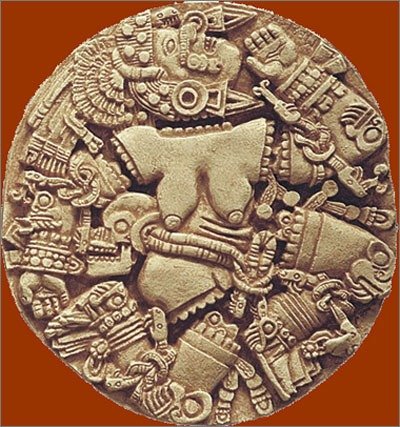 And when we entered the city of Iztapalapa, the sight of the palaces in which they lodged us! They were very spacious and well built, of magnificent stone, cedar wood, and the wood of other sweet-smelling trees, with great rooms and courts, which were a wonderful sight, and all covered with awnings of woven cotton.
And when we entered the city of Iztapalapa, the sight of the palaces in which they lodged us! They were very spacious and well built, of magnificent stone, cedar wood, and the wood of other sweet-smelling trees, with great rooms and courts, which were a wonderful sight, and all covered with awnings of woven cotton.
When we had taken a good look at all this, we went to the orchard and garden, which was a marvelous place both to see and walk in. I was never tired of noticing the diversity of trees and the various scents given off by each, and the paths choked with roses and other flowers, and the many local fruit-trees and rose-bushes, and the pond of fresh water. Then there were birds of many breeds and varieties, which came to the pond. I say again that I stood looking at it, and thought that no land like it would ever be discovered in the whole world . . . But today all that I then saw is overthrown and destroyed; nothing is left standing
Well, I would not say nothing. Much of it is there waiting to be unearthered.
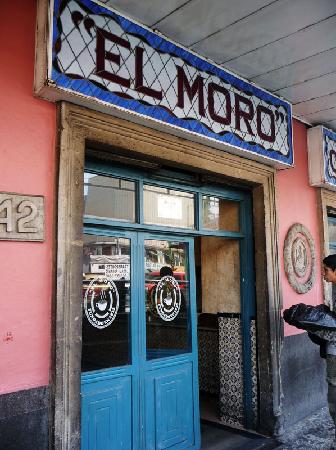
And about those traveling merchants . . . along with jade and quetzal feathers, they also traded in chocolate.
When you are in Mexico City, you must go to El Moro for a cup of hot chocolate—they have four different kinds— and a churro. Rick Bayless just created a little restaurant in Chicago–XOCO— which tries to duplicate the hot chocolate of El Moro, just to give you an idea of how good it is.
When I’m at home and I want to make this treat, I use Mayordomo bittersweet chocolate that I bring back from Mexico. You can use Abuelita or Ibarra, but the most important thing to use is a molinillo, sort of a wooden whisk, which is used to froth the milk.
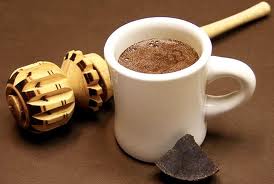 I was told by a cook in Oaxaca that the Mexican believe you are transferring your energy into the drink.
I was told by a cook in Oaxaca that the Mexican believe you are transferring your energy into the drink.
Be sure to make this by hand and with love! For that, a blender just won’t do.